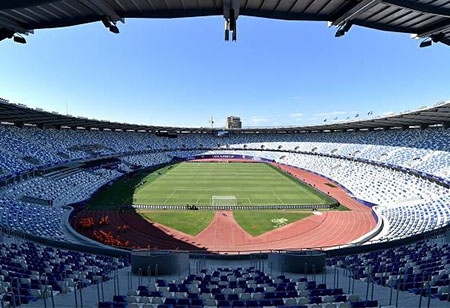Discover the rich history of Tbilisi arena hosting UEFA Super Cup final

Georgia’s national stadium has undergone a 20 million GEL facelift ahead of tonight’s UEFA Super Cup match featuring world class football teams FC Barcelona and Sevilla FC.
The latest upgrade has seen the facility transform from a small stadium, when it was first built in the 1930s, to a world-class arena. The vibrant history of the stadium and its many former names tells the tale of the ever-changing history of the country.

An archived image showing the original Beria Dinamo Stadium, built in 1936. Photo from Kurdiani archive www.dynasty.ge.
In recent months workers ripped out and replaced all the seats at the Boris Paichadze Dinamo Arena, upgraded the sound and lighting system and overhauled the entry gates to ensure the central city stadium meets international standards.
Furthermore, a special lift offering wheelchair access has been installed together with ramps and special seating for people with disabilities and their companions. These changes mean Dinamo Arena is the first stadium in Georgia and the wider Caucasus region to cater to the needs of Georgia’s disabled community.

All of the seats were removed and replaced in the renovation of Boris Paichadze Dinamo Arena. Photo by UEFA Champions League Facebook page.
Players, athletes and sporting officials will also benefit from the changes. The locker rooms have been renewed and spaces used for doping control have been created.
In the stands, Dinamo Arena now offers three offices for team representatives as well as 52 corporate boxes (also called Sky Box) for special guests.
Today the UEFA Champions League posted the pictures of Dinamo Arena Tbilisi on its official Twitter account saying that the stadium "looks glorious”:
It is #SuperCup day! The Boris Paichadze Dinamo Arena looks glorious... pic.twitter.com/Fy3YgfnPWo
— Champions League (@ChampionsLeague) August 11, 2015
The media area has not changed but undergone a vast improvement; the upper storey fitting 80 tables has been designed for TV and radio commentators while the lower area was for print and online journalists.

The Boris Paichadze Dinamo Arena now has a new scoreboard, lighting and sound systems. Photo by UEFA Champions League Facebook page.
This was not the first time the national stadium has been renovated. The facility – primarily used for football and more recently rugby – has a vast history and has undergone many name changes and facility upgrades since it was first built in 1936.
Initially the 23,000 capacity stadium was designed by local architect Archil Kurdiani and it was initially given the name Dimano Arena. One year later it was renamed Beria Dinamo Stadium for the next 16 years, after Stalin’s right hand man Lavrentiy Beria. In 1960-1062 the stadium was redesigned by Kurdiani and his architect son Gia, who expanded the capacity to 36, 000.
Thirty years later, in 1976 the stadium was renewed, number of subscribers increased to 78 000. In 2011 when it was renamed Boris Paichadze Dinamo Arena after the renowned Georgian footballer. Paichadze played for FC Dinamo Tbilisi. The current capacity of the arena is just over 54,500.
Read also:
 Tweet
Tweet  Share
Share